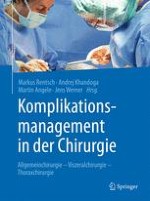Zusammenfassung
Viele der bisherigen geschilderten Präventionsstrategien leiten sich aus Erkenntnissen zu chronisch entzündlichen Darmerkrankungen ab. Dennoch existieren mittlerweile einige chirurgische Standards, die Komplikationen bei dieser speziellen Chirurgie vermeiden sollen und Erkrankungsrezidive und langfristige Folgeprobleme abwenden, bzw. damit die Lebensqualität der Patienten nachhaltig positiv beeinflussen. Der Anteil an Dünndarmchirurgie bei Eingriffen zu Colitis ulcerosa ist naturgemäß relativ gering. Es existieren 2 chirurgische Standardsituationen hierzu: Die Anlage eines Ileostomas (temporär als doppelläufiges, bzw. permanent als einlumiges Stoma) und die Bildung eines ileoanalen Pouches.











